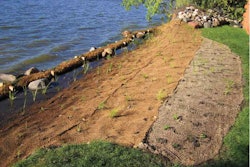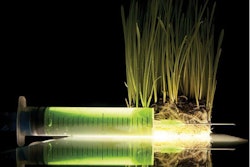Adding these agents to the mix can increase coverage, adhesion and penetration.
Adjuvants are products designed to enhance the performance of pesticide applications. In basic terms, they increase the effectiveness of pesticides by helping get them where they need to be. Adjuvants cause pesticides to stick to plants, spread over leaves or penetrate plant material.
“An adjuvant refers to something added to your spray tank that will enhance everything else in the tank,” explains Andy Moore, director of marketing and business development for Aquatrols. There are many different types, including surfactants, wetting agents, stickers, extenders and plant penetrants, but several of these actually do the same thing.
“Surfactant is the broadest term,” Moore says, “developed by combining the words ‘surface active agents’ and describes the interaction between two surfaces.” In this instance, those surfaces include water surface to leaf surface, water surface to soil surface or even water surface to the surface of the air. For the purpose of surfactants used in turf and ornamental chemical application, you should consider the term as one describing an additive that helps two surfaces come together.
A wetting agent is a type of surfactant that, when added to your spray, reduces the surface tension of the liquid so it will spread more easily over the leaf, increasing chemical distribution. Soil surfactants or soil wetting agents work using the same principles, getting water and active ingredient to move more effectively into the soil, Moore says.
“The use of a wetting agent in a spray tank really gets you better coverage, optimizing the chemical’s performance by placing it more effectively on the leaf,” says Moore. “And it allows you to use less of the chemical, applying at the lower end of the label rate.” Since the cost of the adjuvant is less than that of the chemical, adding an agent into the mix can save chemical dollars, too.
Selecting Surfactants
Many labels recommend the use of a general wetting agent to enhance performance of their product, and some are specific, listing a compound that works best.
Conversely, some labels recommend against using a wetting agent because of elements in the product formulation that could potentially result in compatibility issues or because increasing the penetration of the product too much might make foliage heat up, causing damage.
Some products have wetting agents built-in or an emulsifier, so it’s critical to read the label and follow the recommendations.
The use of a wetting agent in a spray tank provides better coverage, optimizing the chemical’s performance by placing it more effectively on the leaf.
If the label does not specify one way or the other, you should explore incorporating one into your mix. When choosing, “consider the type of chemical you are using and the plant material involved. If you’re applying an herbicide to a hardy plant with a waxy surface, adding a wetting agent will net good results,” Moore says.
“Basically, getting good coverage over the leaf and in all the nooks and crannies is Job One. If you’re successful at that, you – and your client – will see the results.”
Mixing and Not Mismatching
When combining chemicals or amending them, mixing order is critical. Some pesticides can be combined only if you mix them in the proper order. Not doing so results in incompatibility and a potential for toxicity. Always refer to the label to find mixing directions. If you don’t find them there, use the W-A-L-E guidelines for mixing. Add:
Wettable powders and water-dispersible granules.
Agitate the mix thoroughly.
Liquids, surfactants, and flowables.
Emulsifiable concentrates.
Soil Surfactants Strengths
Much attention is given to foliar surfactants, but Moore says applicators should also familiarize themselves with the benefits of soil surfactants. “Often, people don’t think about soil drenches or sprays,” he says. However, these products are effective for getting chemicals where you need them. “They decrease runoff, so they are excellent additives when spraying on slopes or areas where you are especially concerned about runoff (near water sources).” Soil surfactants will take your chemical and carry it into the soil.










